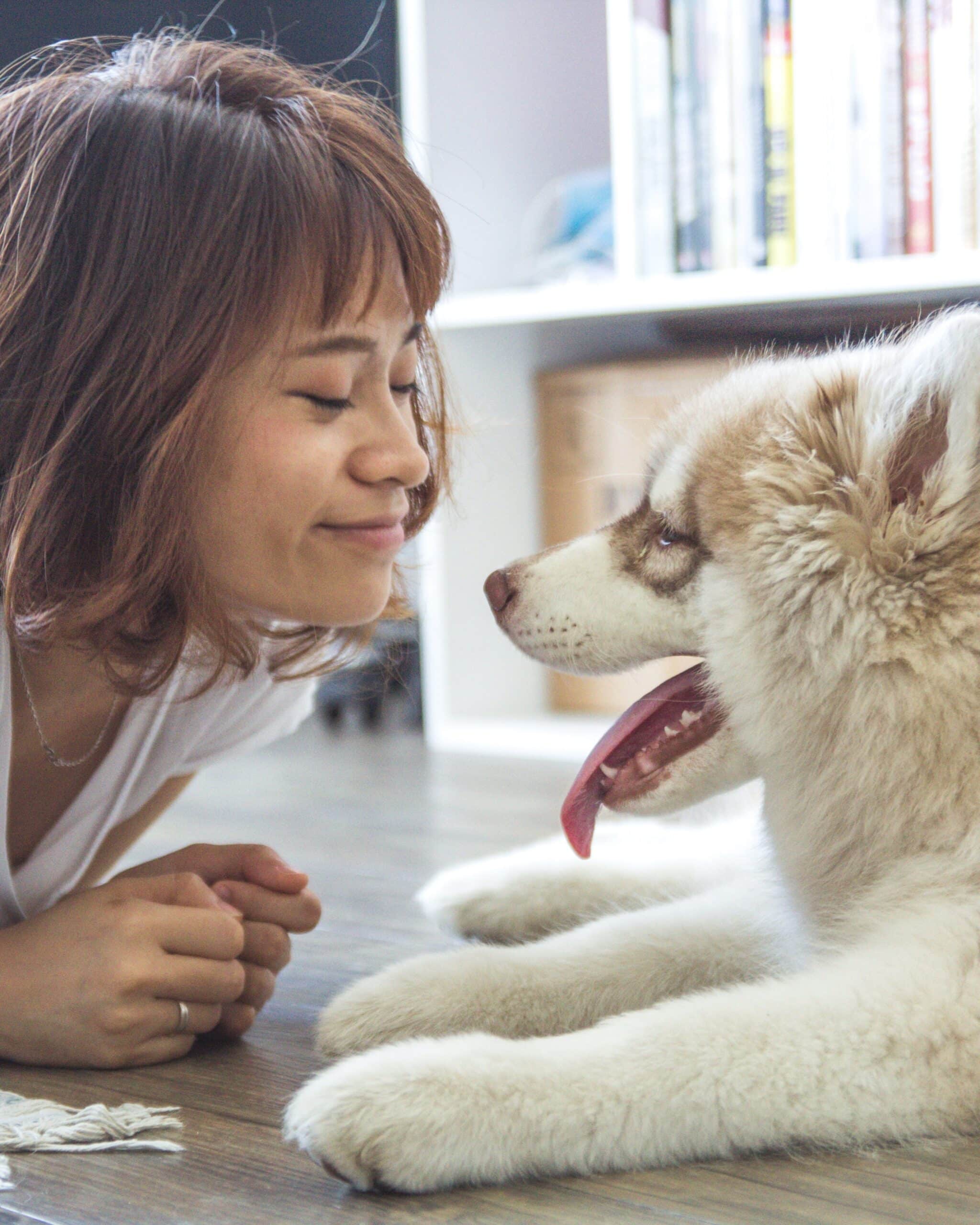Hiya Gorgeous!
If you have a pet or have in the past, then you know all about that special kind of love between fur babies and their humans. They brighten our days with sloppy wet kisses and snuggles, encourage us to get outside and play, make us laugh with their silly antics, and add meaning to our lives in so many other wonderful ways.
And because we love them so much, we want them to be just as happy as they make us. We hate to see them stressed out, anxious, sad or confused. I don’t know about you, but I’d do just about anything to make Lola feel better when she’s having a tough time.
But because we don’t speak the same language (even though sometimes I swear she knows exactly what I’m saying!), it can be hard to figure out what’s bothering them and how we can help.
That’s why I’m so excited about today’s post.
Amanda Ree, the incredible founder of Sama Dog, is on a mission to help humans and their canine pals find a state of balance (or “Sama”). Amanda and her team do this by considering all aspects of a dog’s life, including diet, exercise, personal history, mind-body type (known as their “dosha”) and several other factors. Honestly, I could gush about Amanda and her innovative, holistic approach to our furry friends’ well-being for hours, but I don’t want to wait another minute to hand this post over to her.
I think you’re gonna love these tips for helping relieve anxiety for your pup. Make sure to grab the free guided meditation—yes, it’s for you and your dog to do together!
Take it away, Amanda!
Calming Techniques for Anxious Dogs
By Amanda Ree, Sama Dog
Thanks, Kris!
Dogs are brilliant little beings. Get close to one and your life is instantly filled with more laughter, less stress and a furry reminder to live in the present moment. This is exactly why therapy dogs are so popular—because they work! But what about the canine that needs their own therapy dog?
What Canine Anxiety Looks Like
Just like humans, there are pups in our lives who suffer from anxiety. Physically, canine anxiety may manifest as shaking, panting, licking or pacing. Behaviorally, an anxious dog might also urinate, excessively lick/bite themselves or even try to escape.
If left untreated, the added stress takes a similar toll as in humans, creating imbalances in the body that promote illness, disease and a lower quality of life. Luckily, we can prevent this by using our personal human-animal bond to help a dog with anxiety.
Help Your Dog by Helping Yourself
It might help to know that we commonly share our current state of mind with our canine companions—it’s something we regularly see evidence of at Sama Dog. Clients with anxiety or even sensitivities to touch, food or noise often arrive with a human companion suffering from the same ailment. It’s called mirroring, and the solution often lies in treating the human first.
The impact you have on your furry friend is real. Are you experiencing emotional turbulence, anxiety, stress or overwhelm? If so, then it’s time to begin constructing a balanced lifestyle for yourself. Make yourself a priority to help your dog. Set time aside for the things you enjoy and re-commit to regular exercise, relaxation, quiet time and healthy eating. As you become more relaxed and at ease, so will the canine in your life.
Meditate Together
An excellent foundation for a more balanced life is meditation. Studies show that it can have long-term beneficial effects when used to treat anxiety. Even a few minutes each day can positively influence mood, behavior and emotions by decreasing stress hormones and increasing the happy ones.
The peacefulness of meditation is a natural tonic to a canine’s nervous energy and it’s easy to include them because dogs are natural meditators. Simply sit with your pup in a quiet, comfortable space and bring your attention to your breath. When your mind begins to wander, recognize this and come back to your breath. Remember, this ebb and flow is the practice of meditation.
Sama Dog has seen a consistent meditation practice bring better health and wellbeing to many, many dogs and their humans. To get you started, I created a free guided meditation for you to do with your pup. Download it below!
Canine Anxiety Triggers
While some dogs suffer from general anxiety, many have specific triggers that make them feel nervous or fearful. Here are some of the most common, and how you can help.
Separation Anxiety
Many dogs are worried you’ll never come back. Teach them you’ll always return by easing into it. Prepare as if you’re going to leave for a while but be gone for only 1 minute. A few hours later, leave for 4 minutes. The next day, try 8 minutes, and very slowly build the duration over a week until they remain calm while you’re out of the house.
Meeting New People
Enlisting the support of several patient, dog-loving friends, ask the “stranger” to first allow your dog to approach them, using a treat or favorite toy as a reward. When your dog becomes comfortable with this, allow the human to do the approaching. Repeat this process with several friends. Limit your dog’s exposure to actual strangers until you can condition a favorable experience with new people.
Past Trauma/Abuse
Building trust with your dog is the golden ticket to every human-canine bond. Be hyper-aware of creating a positive association for them with all your interactions. Especially for dogs with anxiety due to poor treatment by humans, dominance and training with punishment must be avoided.
Our pups ask for so little and in return provide us with an abundance of friendship, joy and unconditional love. They magically lower our stress levels with just their presence, so why shouldn’t we help manage theirs? Lucky for us (and them) this requires no doctor visits or doggy Xanax, only some dedicated time, understanding and much love.
Thanks, Amanda!
I hope that you and your furry friend find some time soon to meditate together or try another one of Amanda’s wonderful tips. I know that Lola and I will be tuning in to the guided meditation next time we both need to release some stress (don’t forget to get it here!).
And as you figure out what works for both you and your pup, keep in mind that anxiety is totally normal—just like it is for us. Take your time, practice patience and recognize when they make progress. I’ll be sending you both lots of love and stress-free vibes along the way!
Your turn: Does your canine BFF experience stress or anxiety? Which techniques have you tried (or plan to try) to help them feel calmer and more at ease? Let us know in the comments below!
Peace and furry friends,



Really thank you for the tips and for yout blog in general. I am sure these techniques might come in handy!
Thank you for the tips. My dog, suffers greatly with bad anxiety in storms, I will definitely be giving them a try.
That’s Great and Lovely steps
I also have the dog and I don’t easily handle. I want to learn more tips and tricks about dogs and their behaviors what they want and how they react. Thanks for sharing.
Hey, Kris & Amanda,
great topic and tips!
I have an adopted dog that used to be a street-dog. She was found injured and because of the injury one of her front legs had to be amputated. When I adopted her, she was scared of everything. Dogs, people, inmate objects, cats, collar, lead … and she had strong separation anxiety which resulted in deconstruction. After working with her and a lot of patience, things really improved. I can say she is a happy and satisfied dog now. The main problem at the moment is that she still gets really anxious around dogs she does not know. So, walking her can be really stressful for her as well as the one who is walking her. When I say anxious, I mean getting completely out of herself, barking, trying to get of the leash when meeting an unknown dog, even from the distance.
Do you have any tips, how to approach this issue? Are these issues maybe covered in the program as well?
Thank you in advance,
T.
T, I also wanted to suggest using the technique that I mentioned in the blog — asking some friends to be ‘actors’ and help with your training. Using the training theory of distraction to something more favorable when facing a trigger (food, toy, etc), have your friends with their dogs set-up to approach so you can work your dog through the exercise. Start with good a distance, get her comfortable with that, and then slowly decrease the distance. Basically you’re aiming to create a different memory associated with the action, but this can take some time. It sounds like you’ve brought her quite far already in her level of comfort, so with patience and the right setup, you will likely be able to get her increasingly more comfortable. Hopefully this can help also!
Amanda,
thank you very much for your reply, advice and encouraging words!
It is true that we’ve came a long way already. She is the most lovely, loving, cuddly, funny dog around. And she adores people, kids especially. But still, there are triggers we have to work on to lover the stress for her.
I will check out the resources you suggested.
We are moving in a few weeks to the city where some of my friends with dogs live, so I will definitely try your approach and ask them to help with their dogs!
Thank you so much,
T.
Hi…the link for the meditation is saying “email invalid” but it’s not invalid and I’ve double-checked my typing…:). Any help is appreciated. Thanks!
Sorry to hear you’re having trouble, Joni! Please email my team at info@kriscarr.com and they’ll help you out. Thank you 🙂
Actually I have a question. I am grieving and I know that I need to cry and, well…grieve to heal. But I am concerned about my dog. She feels what I feel and I don’t want her to be sad or upset because I am. What am I supposed to do in a situation like this? Thank you.
Hello Laurie. I’m very sorry for your loss. Your sincere concern for your dog shows that you’re very connected, aware of the energy exchange, and how “in tune” they are with our emotions.
Grief is one of life’s most significant challenges. It can come without warning and can feel endless in its duration. We aren’t alone in our grief. Dogs experience loss in much the same way we do, mourning deeply for the passing of a human or animal companion. Although you may be concerned about how your emotions will impact your furry friend, it’s likely she wants to understand the situation even more and WANTS to help you through this difficult time. Talk to her. Explain what’s happening and how you’re feeling. Let her fur absorb your tears. It’s ok – that’s what true friends are for. If you explain and help her to process it, together you can go through this difficult part of your life path. Just as important as it is for you to release and allow, she too will be benefited emotionally, behaviorally and physically by this unified process.
I recently wrote an article for a large dog wellness publication about this topic. Being that it’s still in print form, I don’t have a link to send you. But happy to provide it via email, if you’d like to write me, I can send it to you.
( connect@samadog.com )
We’ll be holding you both in our hearts.
With love, Amanda Ree
Thank you so much.